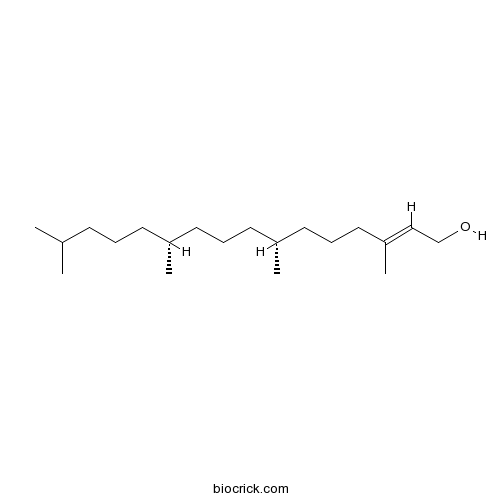Mallotus peltatus
Mallotus peltatus
1. The products in our compound library are selected from thousands of unique natural products; 2. It has the characteristics of diverse structure, diverse sources and wide coverage of activities; 3. Provide information on the activity of products from major journals, patents and research reports around the world, providing theoretical direction and research basis for further research and screening; 4. Free combination according to the type, source, target and disease of natural product; 5. The compound powder is placed in a covered tube and then discharged into a 10 x 10 cryostat; 6. Transport in ice pack or dry ice pack. Please store it at -20 °C as soon as possible after receiving the product, and use it as soon as possible after opening.
Natural products/compounds from Mallotus peltatus
- Cat.No. Product Name CAS Number COA
-
BCN1673
Phytol150-86-7
Instructions

Anti-herpes virus activities of bioactive fraction and isolated pure constituent of Mallotus peltatus: an ethnomedicine from Andaman Islands.[Pubmed: 22624581]
Viral infections, particularly the infections caused by herpes simplex virus (HSV), represent one of the most serious public health concerns globally because of their devastating impact. The aim of this study was to evaluate the antiviral potential of methanolic crude extract of an ethnomedicine Mallotus peltatus, its active fraction and pure compound, against HSV-1 F and HSV-2 G.
Dose-dependent therapeutic antiinfectives from ethnomedicines of bay islands.[Pubmed: 16636538]
The methanol extract of Ophirrhiza nicobarica, Alstonia macrophylla and Mallotus peltatus, ethnomedicines of Little Andaman, were investigated for antiinfective, antiinflammatory and antioxidant activities.
Evaluation of antipyretic activity of leaf extracts of Mallotus peltatus (Geist) Muell. arg. var acuminatus: a folk medicine.[Pubmed: 12587693]
A study was carried out to evaluate the anti-pyretic potential of the methanol extract of Mallotus peltatus (Geist) Muell. Arg. var acuminatus leaf, a folk medicine of Onge tribes of Bay Islands, on normal body temperature and yeast-induced pyrexia in Wister albino rats. The leaf extract at oral doses of 100, 200 and 300 mg kg(-1), p.o., showed significant reduction in normal body temperature and yeast-provoked elevated temperature in a dose-dependent manner and the anti-pyretic effect was comparable to that of standard anti-pyretic agent paracetamol (150 mg kg(-1), p.o.). The effect also extended up to 5 hours after the drug administration.
CNS activity of the methanol extract of Mallotus peltatus (Geist) Muell Arg. leaf: an ethnomedicine of Onge.[Pubmed: 12576208]
The aim of the present study was to investigate several neuropharmacological effects of the methanol extract and different fractions of Mallotus peltatus (Geist) Muell Arg. var acuminatus (Euphorbiaceae) leaves in Wistar albino rats and Swiss albino mice. General behavior, exploratory behavior, muscle relaxant activity and phenobarbitone sodium-induced sleeping time were studied. The results revealed that the crude extract at 200-300 mg kg(-1) p.o. and its fractions A and B at 50 mg kg(-1) caused a significant reduction in spontaneous activity (general behavioral profile), remarkable decrease in exploratory behavioral pattern (Y-maze and head dip tests), a reduction in muscle relaxant activity (rotarod, 30 degrees inclined screen and traction tests), and also significantly potentiated phenobarbitone sodium-induced sleeping time. The phytochemical study of crude leaf extract revealed the presence of tannin, triterpenoid, flavonoid, sterol, alkaloid and reducing sugar. Further fractionation and purification yielded two major fractions A (ursolic acid) and B (beta-sitosterol) with some fatty acids as the major compounds. The psychopharmacological activity of the crude leaf extracts appeared to be either due to fraction A (50 mg kg(-1)) or a combination of fractions A and B (50 mg kg(-1)) along with some fatty acids present in the n-butanol part of methanol extract of M. peltatus leaf (MEMPL).
Antimicrobial and anti-inflammatory activity of folklore: Mallotus peltatus leaf extract.[Pubmed: 12242000]
Since ages Mallotus peltatus (Geist) Muell. Arg. var acuminatus (Euphorbiaceae) leaf and stem bark is used in folk medicine to cure intestinal ailments and skin infections. In several intestinal ailments, localized inflammation is of common occurrence and hence we have evaluated the antimicrobial as well as anti-inflammatory activity of M. peltatus leaf extract. The crude methanol extract of M. peltatus leaves was found to be active against Staphylococcus aureus, Staphylococcus saprophyticus, Streptococcus faecalis, Bacillus subtilis, Escherichia coli and Proteus mirabilis and the dermatophytic fungi Microsporum gypseum. The minimum inhibitory concentration (MIC) ranges from 128 to 2000 microg ml(-1) for bacteria and 128 mg ml(-1) for fungi, while the minimum bactericidal concentration (MBC) was 2-4-fold higher than MIC. The methanol-water fraction of the extract showed similar activity against Staphylococcus, Streptococcus, Bacillus and Proteus isolates. The anti-inflammatory activity of the extract against carrageenan (acute model) and dextran-induced (subacute model) rat paw oedema and cotton pellet-induced granuloma (chronic model) in rats were studied using indomethacin (10 mg kg(-1)), a nonsteroid anti-inflammatory drug, as standard. The methanol extract at 200 and 400 mg kg(-1), and the n-butanol fractions A and B at 25 mg kg(-1), exhibited significant anti-inflammatory activity in Albino rats, compared with indomethacin. Phytochemical study revealed the presence of tannins, saponins, terpenoids, steroids and reducing sugars in the crude extract while the n-butanol fractions showed the presence of ursolic acid, beta-sitosterol and some fatty acids as major compounds. Further study with fractions showed that the antibacterial and anti-inflammatory activity is due to either fraction A (ursolic acid) alone or the combination of fractions A and B (beta-sitosterol and fatty acids) of the extract.


